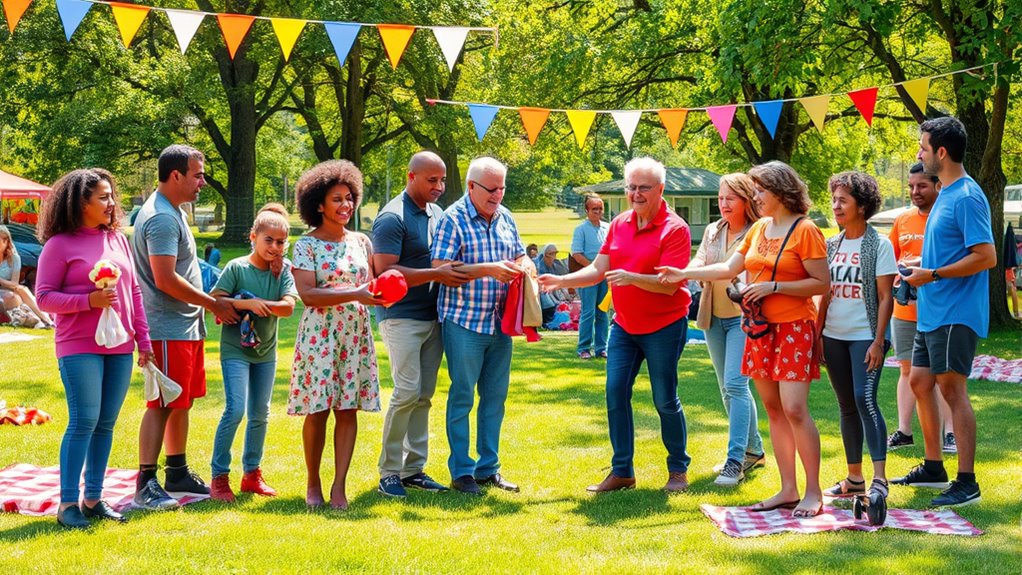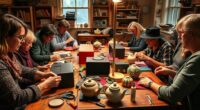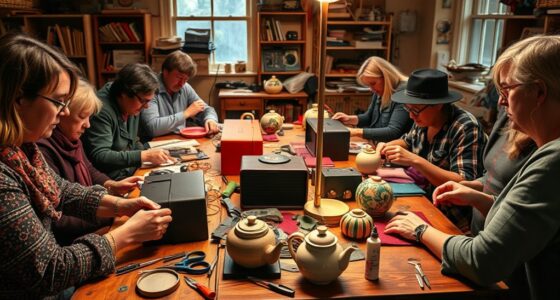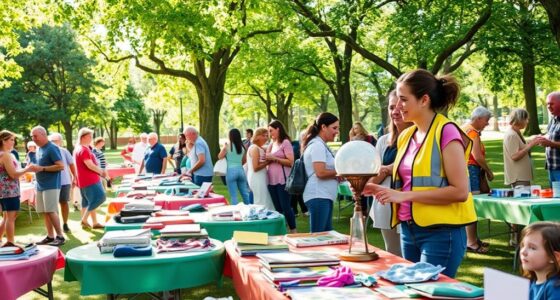Community swaps are fun events where you bring clothes, toys, and tools to exchange with neighbors. You check in, receive tokens or tickets, and browse designated areas for items you want. This promotes recycling, saves money, and builds connections with others. To make yours successful, plan the event thoughtfully with clear rules and organized categories using visual cues. Keep going to discover more tips for hosting or participating in a smooth, eco-friendly swap.
Key Takeaways
- Community swap events facilitate the exchange of clothes, toys, and tools to promote reuse and reduce waste.
- Participants check in, receive tickets, and browse designated areas for desired items.
- Items should be clean, safe, and in good condition, with clear guidelines for categorization.
- Visual cues and display setups help assess item quality and organize exchanges efficiently.
- Swaps strengthen community bonds, encourage sustainable living, and offer free access to useful items.
How Community Swap Events Work
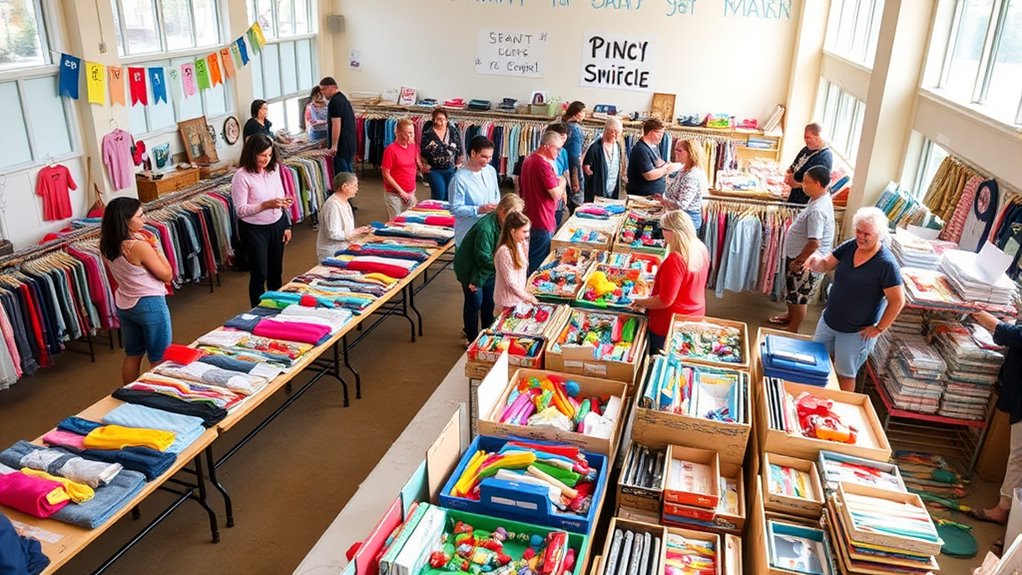
Community swap events bring neighbors together to exchange items they no longer need, making it easy to find new homes for clothes, toys, books, and more. When you arrive, you typically bring clean, gently used items you want to swap. You’ll usually check in at a registration table and receive a ticket or token. As the event begins, you browse the tables or designated areas to find items you want. You can select items from others’ donations, and sometimes, you can trade your items directly. Some swaps operate on a point or ticket system, where you earn credits for bringing items and spend them to take home new ones. These events are casual, friendly, and designed to encourage sharing, recycling, and community connection. Participating in community swaps can also help you discover popular items like clothes, toys, or tools that are in high demand. Additionally, these events promote sustainable living by reducing waste and encouraging reuse within your community. Understanding item categorization can help participants better organize and select items that suit their needs and preferences. Incorporating imaginative play items such as toys and arts and crafts can make swaps more appealing to children and families alike.
Benefits of Participating in Swaps
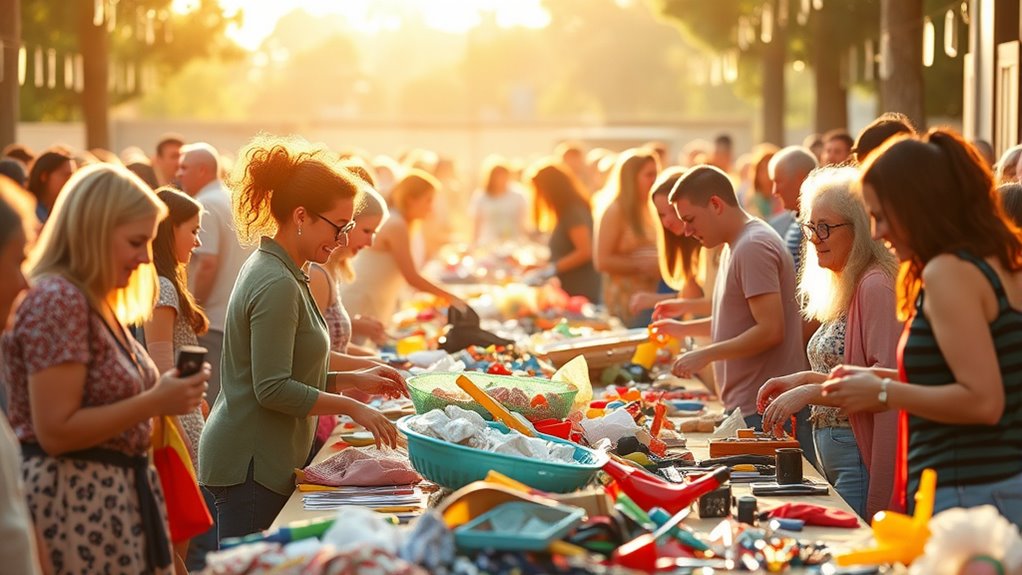
Participating in swap events offers numerous benefits that extend beyond simply exchanging items. First, you save money by reusing things instead of buying new. Second, you reduce waste, helping the environment by keeping items out of landfills. Third, you build stronger community connections as you meet neighbors and share resources. Swaps promote sustainability, making it easier to live eco-friendly. They also give you access to unique or higher-quality items without extra cost. Plus, swapping encourages mindful consumption, helping you focus on what you truly need. Engaging in clothing and item exchanges can also introduce you to new styles and products you might not have discovered otherwise. Additionally, participating in swaps can foster a sense of trust and collaboration within your community, strengthening social bonds. Being mindful of the benefits of reuse can motivate more people to participate in these environmentally conscious activities. Moreover, the process of swapping can lead to a greater appreciation for minimalism and organization, which aligns with decluttering principles. Participating in these activities can also increase awareness about sustainable living and how small actions contribute to larger environmental goals. Overall, engaging in swaps is a practical, eco-conscious way to enrich your life and strengthen community bonds. It’s a win-win that benefits you, your neighbors, and the planet.
Tips for Organizing a Successful Swap

Organizing a successful swap starts with clear planning and open communication. Set a date, location, and guidelines for what can be exchanged. Invite participants early and encourage them to bring items in good condition. To keep things organized, create categories for items like clothes, toys, and tools. Use a simple table to clarify expectations:
| Item Category | Condition Needed | Quantity Limit |
|---|---|---|
| Clothes | Clean, wearable | 5 per person |
| Toys | Complete, safe | 3 per person |
| Tools | Functioning | 2 per person |
This helps everyone know what to bring and reduces confusion. Making a visual display of accepted items can also enhance clarity and better set expectations. Incorporating visual cues can help participants quickly assess the quality of items and streamline the swapping process. Additionally, establishing clear communication channels prior to the event can address questions and promote transparency. Make sure to communicate the rules clearly and assign roles for setup and cleanup. Keeping things organized ensures a smooth, fair, and enjoyable swap for all. Additionally, considering color accuracy can help participants better assess the quality of items, especially when swapping electronics or visually detailed goods.
Frequently Asked Questions
How Do I Ensure the Items I Bring Are Clean and Safe?
To guarantee your items are clean and safe, start by thoroughly washing or disinfecting each item before bringing them to the swap. Check for damage or wear that could make items unsafe. For clothes, wash and dry them at high temperatures if possible. For toys and tools, wipe down with disinfectant and inspect for broken parts. This way, you help keep everyone safe and the community swap enjoyable.
Can I Exchange Items Outside Scheduled Swap Events?
You might think exchanging items outside scheduled events is a small detail, but it can feel like trying to catch lightning in a bottle. While some swaps might permit it, most communities prefer sticking to the designated times to ensure fairness and safety. Check with your local organizer first. If they’re open to it, make sure your items are clean, safe, and meet all guidelines to keep the swap running smoothly and happily for everyone.
Are There Restrictions on the Types of Items Accepted?
You might wonder if there are restrictions on accepting items. Usually, swaps prefer gently used, clean, and functional items. Avoid damaged, broken, or hazardous goods to keep the community safe and fair. Check the specific swap’s guidelines, as some may exclude certain categories like electronics or large furniture. Following these rules guarantees everyone benefits from the exchange and keeps the event enjoyable for all participants.
How Do I Handle Disagreements Over Item Quality or Value?
Addressing disagreements over item quality or value can feel like walking a tightrope. You should stay calm and listen carefully to each person’s concerns. Encourage open communication and aim for compromise. If needed, suggest a third-party opinion or set clear guidelines beforehand. Remember, transparency and fairness help balance everyone’s expectations, turning potential conflicts into opportunities for trust and stronger community bonds.
Is There a Fee to Participate in Community Swap Events?
You might wonder if there’s a fee to join community swap events. Usually, these events are free to encourage participation and sharing within your neighborhood. Sometimes, organizers ask for a small contribution to cover setup costs, but most often, you can attend without paying. Check the event’s guidelines beforehand to know for sure. Overall, community swaps are designed to be accessible and fun for everyone.
Conclusion
As you step into the vibrant swap event, imagine shelves filled with colorful clothes, toys ready for new adventures, and tools enthusiastic for their next project. By participating, you help create a lively community tapestry woven with shared resources and friendly smiles. Every swap strengthens bonds and reduces waste, making the world brighter—one item at a time. So, bring your items, share your story, and leave feeling connected, inspired, and part of something bigger.
